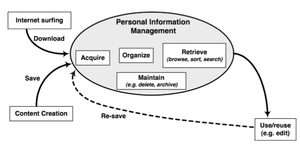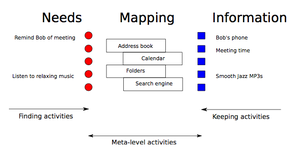Difference between revisions of "PIM frameworks"
| Line 30: | Line 30: | ||
* Meta-level activities: maintenance (composition and preservation) and organization (selection and implementation of a scheme) of the PIC within PSI, managing privacy, evaluating PSI, making sense of information and information distribution. | * Meta-level activities: maintenance (composition and preservation) and organization (selection and implementation of a scheme) of the PIC within PSI, managing privacy, evaluating PSI, making sense of information and information distribution. | ||
| − | The first group of activities is focused on the flow from information to our needs and the second group on the flow from our needs to information. All other activities support both flows as can be seen in Figure 2. | + | The first group of activities is focused on the flow from information to our needs and the second group on the flow from our needs to information. All other activities support both flows as can be seen in Figure 2.<ref name="jonesteevan">William Jones and James Teevan, editors. Personal Information Management. University of Washington Press, 2007</ref> |
==Matjaž Kljun== | ==Matjaž Kljun== | ||
Revision as of 00:40, 2 August 2010
Deborah Barreau
To understand how PIM is performed, Deborah Barreau tried to dismember it and so divided it in 5 sub- activities:[1]
- Acquisition: deciding which information will be included in information space, defining, la- belling and grouping information.
- Organization and Storage: classifying, naming, grouping and placing information for later retrieval.
- Maintenance: updating out-of-date information, backing up information, moving or deleting information from information space.
- Retrieval: process of finding information for reuse and • Output: visualizing the information space based on users’ needs and objectives.
Richard Boardman
Barreau's classification of PIM activities was a basis for Richard Boardman’s classification. Boardman argued that updating information content cannot be a part of PIM, as it deals with content of information items. He also argued that visualizing is done by computers (not users) and that visualization is present in all sub-activities. He describes four PIM sub-activities as:
- Acquisition: naming and/or (deciding of a) placement in information space.
- Organization: placing information items, renaming, moving and creating new folders.
- Maintenance: backing up and deleting information from information space.
- Retrieval: browsing, sorting and searching for information.
William Jones and James Teevan
Jones and Teevan devided all PIM activities in three main groups that support our needs in correlation to information:
- Keeping activities: decisions focused on a single information item about the future needs and future availability.
- (Re)finding activities: driven by our needs for information in PSI.
- Meta-level activities: maintenance (composition and preservation) and organization (selection and implementation of a scheme) of the PIC within PSI, managing privacy, evaluating PSI, making sense of information and information distribution.
The first group of activities is focused on the flow from information to our needs and the second group on the flow from our needs to information. All other activities support both flows as can be seen in Figure 2.[2]
Matjaž Kljun
a framework of keeping activities only
CEO model
http://portal.acm.org/citation.cfm?id=1277989
http://www.cs.ubc.ca/~mike/master.pdf (pages 96, 109)

